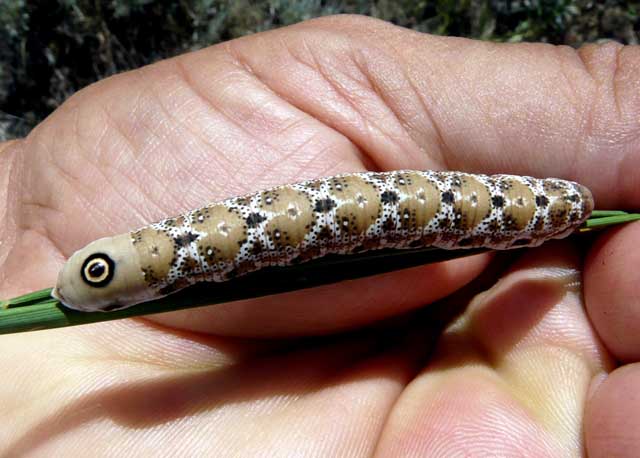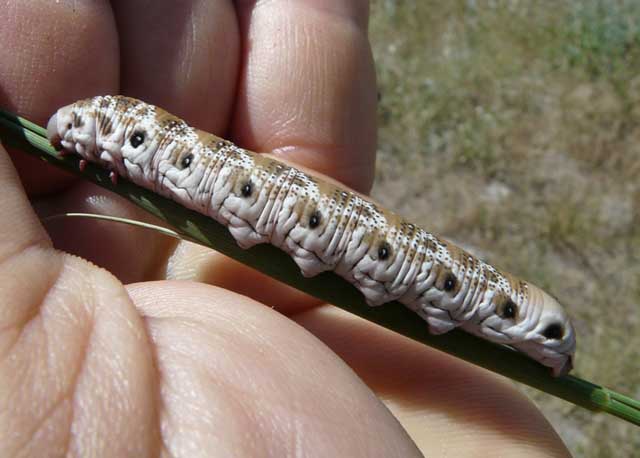Sphinginae subfamily
Sphingini Tribe:
 |
Note the pinkish-orange tail, spiracles outlined in red and the cream
stripes on the head.
The dramatic color change from the dorsal
yellow-green to the lateral light greyish-blue is not always
as intense as in this image.
|
 |
Larvae hide in the day and feed primarily on cherry, plum, and apple
at night. Larvae have been found on Amelanchier nantuckensis
in Massachusetts and have been reared to pupation in Michigan on
Prunus serotina. Note purple oblique lines.
|
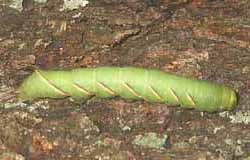 |
Sphinx luscitiosa
WO,
the Canadian Sphinx or
Clemen's Sphinx
This one is reported from Richmond and from northeastern New
Jersey into southern Canada.
|
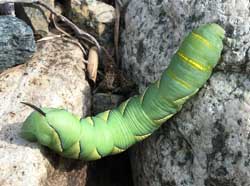 |
Sphinx vashti
USGS,
the Snowberry Sphinx
Larvae feed on the common snowberry (Symphoricarpos albus)
and on coralberry (S. orbiculatus). Note the two golden
lines of slightly raised bumps, one just behind the head, the other
on the thorax.
|
Smerinthini Tribe:
 |
Pachysphinx modesta
WO,
the Modest Sphinx or Poplar Sphinx
This moth is officially recorded in Delaware County. It is fond
of poplars and
willows.
|
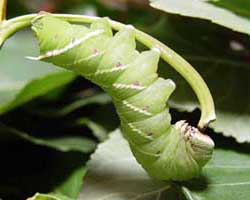 |
Larvae feed on cottonwood and poplar (Populus) and willow
(Salix).
Larvae are very chunky with little to distinguish them
from Pachysphinx modesta.
|
 |
Larvae accept willows, birches, and cherries.
I have also found them in the wild on oak in eastern Canada.
|
 |
Wild cherry species are the favorites as larval foodplants, but eggs
will also be deposited on birches and other forest trees.
There are varying degrees in the amount of red markings along the sides.
|
 |
Smerinthus cerisyi
WO,
Cerisy's Sphinx;
Cerisyi larvae greatly resemble modesta larvae, both being pale
green, with granular skin, pale lateral diagonal lines, faint red
spiracular circles, and very pale longitudinal lines running from the
head to a more pronounced anal diagonal line.
Larvae have green heads bounded dorsally with a pale yellow
inverted "V".
|
Macroglossinae subfamily
Dilophonotini Tribe
 |
Hemaris thysbe
WO, the Hummingbird Clearwing
There is also an orangey-pink prepupal form. The lateral line runs
from S1 to the blue horn.
Hemaris thysbe larvae feed on viburnum and related plants.
|
 |
Hemaris senta
WO,
the Rocky Mountain Clearwing,
There is probably a single brood of this montane species from
May-August. The moth is seen along streamsides and in meadows in
mountainous areas. sorry, no larval image available
|
Macroglossini Tribe
 |
Hyles gallii
WO, the Bedstraw Hawk Moth
or Gallium Sphinx
Larvae come in black and in brown forms and often feed on
Epilobium (fireweed).
|
 |
Hyles lineata
SH, the White-lined Sphinx
Larvae are highly varied and feed on a great diversity of plants
including willow weed (Epilobium), four o'clock (Mirabilis),
apple (Malus), evening primrose (Oenothera), elm
(Ulmus), grape (Vitis), tomato (Lycopersicon),
purslane (Portulaca), and Fuschia.
All larvae seem, however, to have the red/black swellings split by
dorso-lateral lines.
|
Hyles lineata adult moth, Casper,
August 12, 2007, courtesy of Scott Herden.
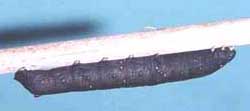 |
Larvae feed on willow weed (Epilobium) and possibly thimbleberry (Rubus parviflorus).
|
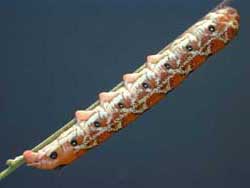 |
Newly-hatched caterpillars eat their eggshells. Larvae feed on
(Onagraceae) including evening primrose (Oenothera), gaura (Gaura),
and willow weed (Epilobium). Michael Van Buskirk has found them on
Guara biennis in Missouri. rare
|
Proserpinus juanita larva found near Casper, July 23, 2009, Dwaine Wagoner.
|
|
